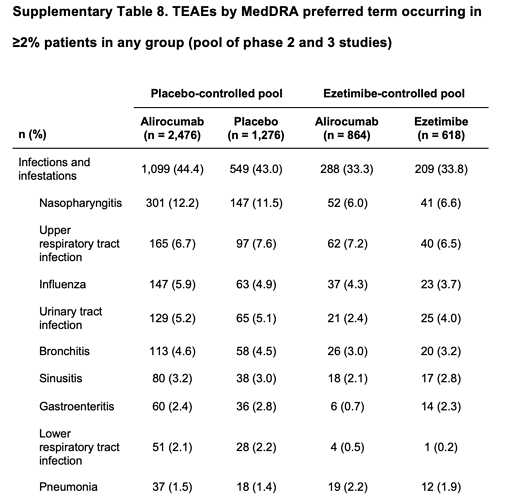Having a very low ApoB does not seem to be a good thing, staphylococcus aureus can be nasty and often resistant to antibiotics
Do you have a randomized controlled trial or mendelian randomization study supporting that conclusion or are you just basing it on a 2008 mice study?
I’m on my 5th dose of weekly dosing. Started at 2mg, next week = 3mg, next week = 2mg w/GFJ, then 3mg w/GFJ and last dose 4mg w/ GFJ caused a larger yellow pimple a couple days later and smaller red spots not raised on cheek. Feel tired 4 days after dose but that could be the result of being a single parent of a 15 year old. If pimples are a red flag, will probably ratchet down to 4mg no GFJ and see how that goes.
Grateful for all the detailed guidance.
Remember that GFJ multiplies the effect by 3X or more. 4 mg + GFJ is equivalent to 12 mg without.
Yes, what I was considering is that given my age (62), coupled with the results of the Joan Mannick study which seemed to support the idea that older folks could handle a higher dose (5mg with relatively few side effects in study chart); and the fact that I had no issue with 3mg + GFJ; and, I was aiming for the optimal dose (where there were no side effects) which required getting to a dose with side effects–in this case 4mg w/ GFJ. I was actually kind of glad that I noticed something as I wasn’t noticing anything before this week.
It just seems like your approach is a little erratic
- Start at 3 mg dose
- Increased to 3 mg + GFJ = 9 mg
- Decreased to 4 mg
- Increased to 4 mg + GFJ = 12 mg
- Decreased to 4 mg
For Step 5, I would have decreased to 3 mg + GFJ. Which is actually my current dosage!
Just my 2 cents…
Totally appreciate this. I felt like if I did a week of a base mg, followed by a week of a base mg + GFJ, I could advance. Super helpful knowing where you have landed.
It’s a wash (see thread):
Please be careful about old mice studies if you haven’t looked up if they are contradicted by randomized controlled trials in humans.
A lot of things in mice, in vitro, ex vivo, mechanistic studies, do not pan out in humans.
IMO: The side effects to look for are not the subjective ones. The ones to look for will be in your blood work. Is your rapamycin dosage raising your lipids outside of the healthy range?
(Yes, I know that there is some debate over the “healthy” range)
Have your red blood cells, iron levels, etc. decreased below the normal range? Has it increased your blood glucose levels to the pre-diabetic range, etc?
I’m a fan of bee propolis for treating mouth sores. I’ve had good luck with this brand
https://www.amazon.com/Canker-Rid®-Immediate-Restore-Quality-GUARANTEED/dp/B003AS74JO/
All good questions, which I cannot answer at this point, as I have not looked into how to get the lab work done and what to ask the lab to test for.
As I say for many things, it’s on my list. ![]()
While not wanting to discourage people from taking statins, you might want to consider a hydrophilic statin such as rosuvastatin/Crestor (which will largely act within its target organ (the liver)) rather than a lipophilic statin such as atorvastatin/Lipitor (which goes everywhere and likely inhibits cholesterol synthesis in the brain).
Mendelian Randomization Study of PCSK9 and HMG-CoA Reductase Inhibition and Cognitive Function
(Because MR reflects genetic variants affecting HMG-CoA activity, it models the effects of lipophilic statins rather than hydrophobic statins as HMG-CoA will be inhibited in all cells, including those in the brain, rather than in a highly hepatoselective action).
desertshores, Another test you may want to consider is “Apo A1 + B + Ratio.”
Agetron, thank you for sharing. Like Maveric78 suggests (asks), current thinking seems to be that ApoB (specifically ApoB-100 by particle count) is the better measure of atherogenic risk. FWIW, if you have ASCVD the standard is treat if LDL > 70 mg/dL. So standard is wait to treat (save money?) until a disease that arguably takes 30 to 40 years to develop then treat. If your internist and cardiologist don’t understand this, I strongly recommend finding ones who do.
Thanks!
Timing is good because I do my blood draw tomorrow morning for my 4 month health checkup. I wIll do ApoB and also Sirolimus LABCORP test to check on my GFJ multiplication - first trough and post dose 2 hours.
I wll do the whole cholesterol check and have the full results next week.
Also, doing a 3rd GlycanAge test too - for inflammation.
“By particle count”.
I didn’t figure this out until AFTER I flatlined. While you’re at it, add Lp(a) to the list if you have never had it. about 15% of humankind inherits it with no currently approved treatment. Can you guess why I’m “lab-rat”? Let me drop a hint: Treatment may be on the horizon.
Please share more - it sounds like you might be in a clinical trial of a new drug coming down the pipeline?
Pretty good. Do you have a “jump to conclusions mat”?
NCT04023552
Ah, that explains it:
Side Effect Report.
I’ve been taking Zydus rapamycin for six weeks now. Scaling up from 1mg first week to 2, 3, 4 and 5 mg. Last week I did 3mg with GFJ. Two days later I had very sore gums for about 4 days. All cleared up now. I plan to take a week off and try again with 2mg +GFJ.
